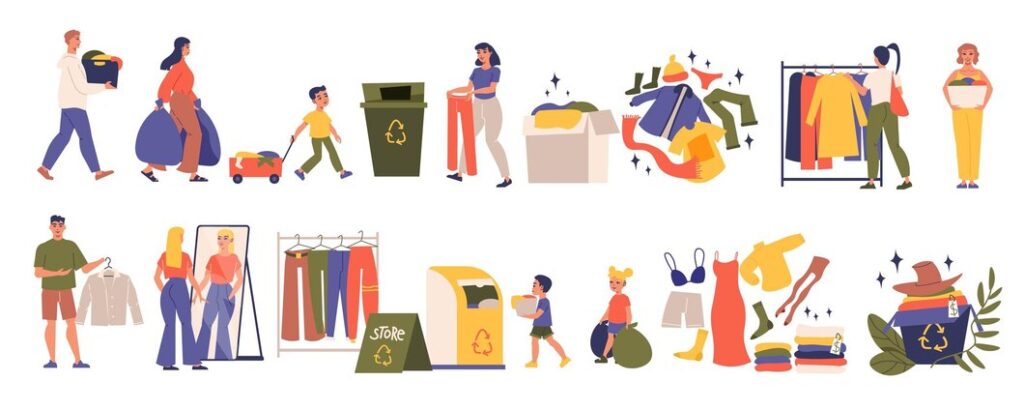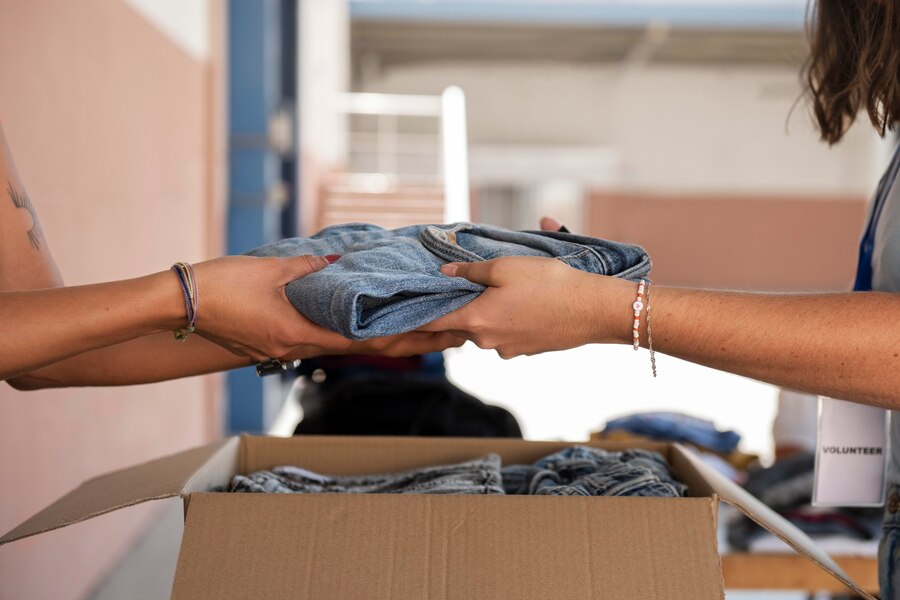6 Eco-Friendly Ways to Dispose of Old Clothes Sustainably
How can you declutter your wardrobe sustainably without generating more textile waste? A wardrobe upgrade can impact the environment, as old clothes that no longer fit or are worn out are often replaced. In today’s fast-paced fashion world, new trends influence fashion enthusiasts to expand their budgets on stylish outfits. However, this constant consumption of the latest fabrics has serious environmental consequences for our planet.
Being fashionable can unintentionally cause irreparable harm to our environment. Textile waste has far-reaching environmental impacts, and if the current trend continues, we’ll see even more waste dumped in landfills. It’s unwise to purchase new clothes to fit a new trend, only to struggle with how to dispose of them later.
As consumers, we must promote sustainability with our choice of fabrics and responsibly dispose of old clothing. In this article, we will explore sustainable options to help you declutter your wardrobe without harming the environment.

In This Article
- The Importance of Sustainably Getting Rid of Old Clothes
- Environmental Consequences of Textile Waste
- Why Sustainable Disposal of Clothes Matters
- Sustainable Clothes Are Already in Your Wardrobe
- Sustainable Ways to Get Rid of Old Clothes
- Innovations in Sustainable Fashion
- Conclusion
The Importance of Sustainably Getting Rid of Old Clothes
Post-consumer textile waste is rarely discussed as a pressing issue when it comes to global environmental pollution.
According to the U.S. Environmental Protection Agency (EPA), over 17 million tons of textile waste were generated in the U.S. in 2018 alone, an increase from the 12.5 million tons recorded in 2000. The global fashion industry is a trillion-dollar industry, producing an estimated 92 million tons of textile waste annually. A significant portion of this textile waste is poorly disposed of in landfills, where it can take hundreds of years to decompose.
The millions of tons of textile waste generated are not unique to any one country. China, a global leader in textile manufacturing, generates over 253 million tons of textile waste annually on average. Another Asian nation, Malaysia, faces a devastating textile crisis, generating over 8 million tons of textile waste each year. This global trend of mounting textile waste calls for urgent sustainable solutions.
Environmental Consequences of Textile Waste
Post-consumer textile waste in landfills takes years to decompose. As this waste decomposes, methane—a potent greenhouse gas—is released. The accumulation of methane in the atmosphere contributes to climate change. Additionally, chemicals used in dyeing and treating fabrics can leach into the soil and nearby water bodies, posing a threat to wildlife and human health. Synthetic fibres like acrylic, nylon, and polyester are essentially plastics that do not naturally decompose. These synthetic fibres make up a significant portion of modern clothing, and many of these materials end up in landfills, where they can take over a hundred years to decompose.
According to a 2017 report by UNFCC, textile production emits about 1.2 billion tons of CO2 equivalent annually—more than international flights and maritime shipping combined. CO2 emissions from textile production are expected to rise by 60% in the next few years if sustainable measures are not prioritised.
Why Sustainable Disposal of Clothes Matters
A general habit of discarding old fabric has led to more textile waste being dumped in landfills, and this trend will continue unless consumers recognise the environmental threat posed by textile waste.
Consumers’ demands have the power to revolutionise the fashion industry by incorporating and prioritising sustainability. According to a Greenpeace report, around 40% of garments in people’s wardrobes are seldom worn. Instead of contributing to the cycle of buying and discarding, consumers should focus on extending the lifespan of their clothes.
Efforts to reduce textile waste at the government level have had mixed results. The European Union, for example, has set an ambitious target to recycle 55% of its textile waste by 2030. However, recycling facilities and sustainable disposal methods remain limited.
Sustainable Clothes Are Already in Your Wardrobe
Sustainable fashion starts with consumers avoiding unnecessary purchases. According to a study by Columbia University, the average consumer buys 60% more clothing today than they did 20 years ago, but each garment is kept for only half as long. This fast fashion culture results in waste on an unprecedented scale.
Expert Insight: Dr Kate Fletcher Lee on Mindful Consumption
Dr Kate Fletcher, a Professor of Sustainability, Design, and Fashion at the University of the Arts London, emphasises, “The single most effective way to reduce clothing waste is to avoid overconsumption. Consumers must understand that every new item of clothing they purchase adds to the environmental burden, whether they keep it or not.”
Dr Kate Fletcher suggests taking a pledge to purchase fewer clothes as a means of promoting mindful consumption. She states, “If we start buying only what we need, we not only cut down on waste but also reduce the demand for environmentally harmful production practices.”
One effective way to implement this is by taking on the challenge of not spending any money on new clothes for an entire calendar year. Committing to this decision significantly lowers your chances of generating textile waste. According to a 2023 study, extending the life of a garment by just nine months can reduce its carbon, water, and waste footprint by 20–30%.
Learn More: 12 Best Green Resolutions for Every Month
Sustainable Ways to Get Rid of Old Clothes
#1. Sell Old Clothes
Selling old clothes for cash is a great way to declutter your wardrobe. If you’re wondering where to find buyers for secondhand clothes, platforms like eBay, Depop, and Poshmark can help connect you with people willing to take those old items off your hands.
Online resale platforms have experienced rapid growth in recent years, with a 2024 report by ThredUp suggesting that the secondhand market is expected to double in size by 2025 and reach $350 billion by 2028. Reselling old clothes is not just about making money from personal items – by doing so, you are also contributing to the circular economy.
Case Study: Vestiaire Collective
Vestiaire Collective is a well-known resale platform in France. The platform has grown exponentially, with its business focused on luxury secondhand fashion. Vestiaire Collective encourages users to recycle high-end items by reselling them, creating a closed-loop system where luxury items retain their value and usefulness for longer.

#2. Donate Old Clothes to Charities or Mutual Aid Organisations
Donating old clothes that are still in good condition to those in need will be greatly appreciated. Look for charities to donate to—The Salvation Army, Goodwill, and Oxfam are organisations that accept clothing donations to help low-income families or communities affected by natural disasters.
However, be mindful of the organisations you donate to, as not all donated items are used locally. According to a 2023 report, many donated clothes are shipped to developing countries, where they often end up in landfills.
Expert Insight: Elizabeth L. Cline and Orsola de Castro on Ethical Donations
Elizabeth L. Cline, author of Overdressed: The Shockingly High Cost of Cheap Fashion, advocates for responsible donations—she strongly recommends researching local organisations before donating your old clothes, as it can have a more direct impact compared to large-scale charities, where items might be sold or shipped abroad in ways that may harm local economies. Additionally, Orsola de Castro, co-founder of Fashion Revolution, has consistently spoken about the importance of ensuring that clothing donations go to the right places. According to Orsola, “While donating clothes is generally a good thing, it’s essential to ensure that the organisation has ethical practices. Many smaller organisations, such as shelters and community-based mutual aid groups, have a direct and positive impact.”
Popular donation destinations include:
- Homeless shelters
- Foster care programs
- Domestic violence shelters
- Youth centers
- Prisons
Always ensure that the clothes you donate are clean and in good condition.

#3. Compost Your Natural Clothes
What if I told you that you can compost clothes made from natural materials like cotton, hemp, and linen? These natural fibres are biodegradable and will decompose fully without harming the environment.
Composting textile waste requires a slightly different process. First, non-compostable components such as zippers, buttons, and synthetic fibres attached to the clothing must be removed. Then, the fabric is shredded into smaller pieces to speed up decomposition. This process reduces the volume of textile waste and returns valuable nutrients to the soil.
Expert Insight: Dr Richard Cole on Textile Composting
Dr. Sally Brown, a well-known soil scientist and professor at the University of Washington, highlights the importance of composting as a solution to organic waste, including textiles from natural fibres. Additionally, Timo Rissanen, an expert in sustainable fashion and zero-waste design, suggested in his 2016 study that composting clothes can be an environmentally sound way to deal with worn-out textiles. The key is to ensure that the fabric is 100% biodegradable and free from harmful chemicals.

Learn More: What Is Textile Recycling and How Does It Work?
#4. Upcycle Clothes
Upcycling allows you to create something new from your old clothes. For example, you can turn old pants into stylish shorts or transform a worn-out dress into fabric accessories like bags or headbands.
Upcycling provides an opportunity to be creative, making customised accessories from old clothes while keeping them out of landfills.
DIY Upcycling Ideas
- Turn old T-shirts into tote bags: T-shirts can easily be upcycled into reusable grocery bags. Simply cut off the sleeves and sew the bottom closed.
- Patchwork blankets: Gather old clothes with sentimental value and stitch them together to create a cosy blanket.
- Transform denim jeans into handbags: Worn-out jeans can be turned into durable and fashionable tote bags.

#5. Recycle Clothes through Textile Recycling Programs
Fabrics that are too old or worn out for resale or donation can be recycled instead of being discarded. Textile recycling programs can transform old clothes into useful new materials like insulation, industrial rags, and even new fabrics.
Many large retailers have initiated textile recycling programs. H&M and Patagonia are two brands that accept old clothes for recycling in exchange for store discounts. The North Face, a global brand, aims to make all its products 100% recyclable by 2030.
Case Study: H&M’s Garment Collection Program
H&M’s Garment Collection Program allows customers to drop off unwanted textiles at any of the brand’s stores. The collected clothes are either recycled or reused, depending on their condition. Since its launch, H&M claims to have collected over 29,000 tons of textiles globally.
Although these initiatives are a step in the right direction to reduce textile waste, critics argue that more systemic change is needed. Recycling clothes does not fully offset the environmental costs of fast fashion. However, for clothes that cannot be resold, recycling is a more eco-friendly alternative to disposal.

#6. Host Clothing Swaps
Clothing swap events connect people who want to declutter their wardrobes by exchanging their clothing with others. These social events encourage the reuse of old clothes without any financial cost.
Clothing swap events are not only fun but also sustainable. You can host swap events with family and friends, or attend community-organised ones to find someone who wears the same size as you.

Innovations in Sustainable Fashion
Looking ahead, several exciting innovations are set to make the fashion industry more sustainable. From biodegradable fabrics to advanced textile recycling technologies, the future of fashion lies in eco-friendly materials and processes.
#1. Biodegradable Fabrics and Textiles
Currently, researchers are developing biodegradable materials that decompose easily once discarded. Orange peel fabric, mushroom leather, and pineapple fibre are sustainable materials rapidly gaining popularity in eco-friendly fashion circles. These materials are cruelty-free and serve as a sustainable alternative to synthetic fabrics.
#2. Circular Fashion and Closed-Loop Systems
The concept of circular fashion is gaining popularity, where clothes are designed to be reused, recycled, or composted at the end of their lifecycle. Brands like Eileen Fisher and Patagonia are leading the way by creating garments intended for long-term use and recycling.
Conclusion
Sustainability in fashion begins with our choices. From how we purchase to how we dispose of clothing, every action counts. By selling, donating, recycling, upcycling, or composting old garments, we can help reduce the fashion industry’s environmental impact.
Adopting sustainable clothing disposal methods is not just about decluttering—it’s about contributing to a healthier planet for future generations. Take action today and make sustainable choices that reflect your values.







